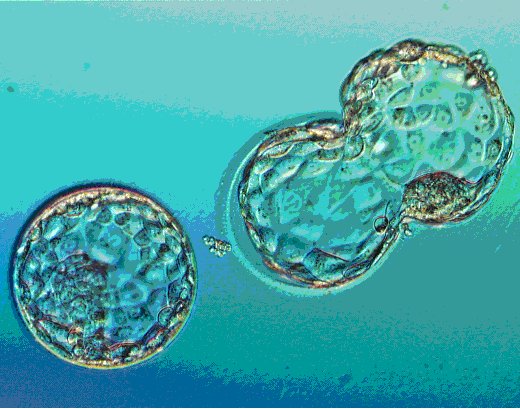Blastocyst transfer is a type of embryo transfer procedure used during IVF. The procedure for blastocyst transfer is similar to that for normal embryo transfer, but instead of being implanted into the womb after two or three days, the embryos are allowed to develop for five to six days before transfer.
A blastocyst
A blastocyst is a highly developed embryo for at least five days after egg retrieval that is the final stage of the embryo’s development before it hatches out of its shell (zona pellucida) and implants in the uterine wall.
The natural procedure for implantation
In the human, the egg is fertilized in the fallopian tube near the ovary. The developing embryo descends through the tube into the uterine cavity about three to four days after ovulation when it is a blastocyst. The blastocyst invades (implantation) the uterine lining about the fifth or sixth day after ovulation so that it can develop a blood supply (placenta) that will allow it to continue to grow into a fetus and then a baby.
Time of blastocyst transfer
Transfer occurs closer to the natural time that an embryo enters the uterus when the uterine lining may provide a better environment for the embryo where it. have a much greater chance of implanting successfully and resulting in an ongoing pregnancy. That is because these embryos have passed an important test that are more highly-developed, healthier, and stronger, and have a higher rate of implantation when compared to day three embryos. Due to the higher probability of survival, we transfer fewer back into the uterus.
Blastocyst transfer may be suitable for the following patients:
- This technique significantly reduces the chance of higher order multiple gestations such as triplets.
- Those who have had negative results after earlier embryo transfers.
- Those who would prefer to avoid a twin pregnancy for other reasons.
In our centre we will often make the decision to transfer blastocysts depending on the number and quality of embryos available three days after egg collection. For example if the laboratory team are unable to select the best two embryos for embryo transfer because there are a large number of rapidly developing, good quality embryos on day 3 they may suggest delaying the embryo transfer to day 5 or day 6.
The risk of blastocyst transfer
The primary risk of attempting blastocyst transfer is that some embryos will die in the laboratory. In case of the poor ovarian responder, the starting number of embryos is low, then the chance of having no embryos for transfer is much higher.

Pregnancy rate
A healthy blastocyst should hatch from its shell (zona pellucida) by the end of six days or earlier and is then ready to begin to implant within the lining of the uterus. The pregnancy rate per transfer is higher when blastocyst embryos are transferred on day 5 to 7 than when earlier-stage embryos are transferred on day 2 or 3. The average success rate in patients under the age of 35 is 46.8%.
Best Doctors
Ut wisi enim ad minim veniam, quis nostrud exerci tation ullamcorper suscipit lobortis nisl ut aliquip ex ea commodo consequat. Duis autem vel eum iriure dolor in hendrerit in vulputate velit esse molestie conse
quat, vel illum dolore eu feugiat nulla facilisis at vero eros et accumsan et iusto odio.

Dr. Andrew Cruize, MD

Dr. Anne William, MD
Opening Hours

